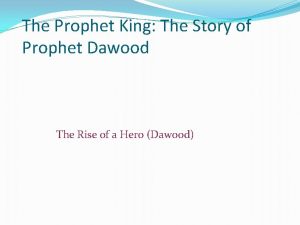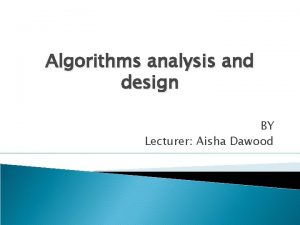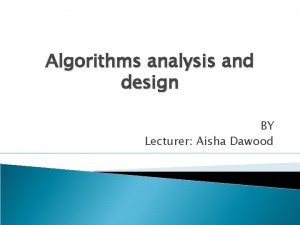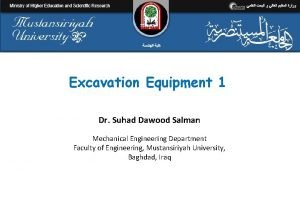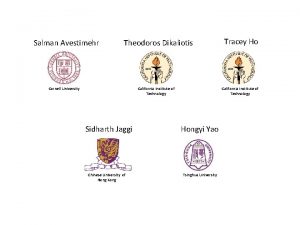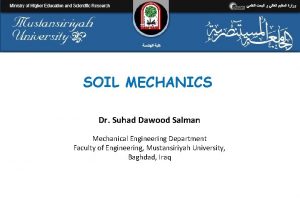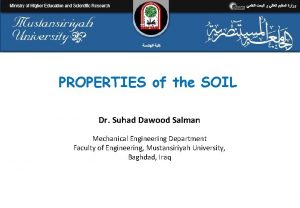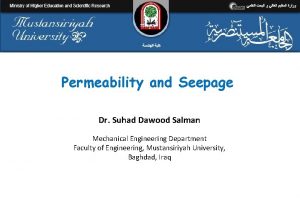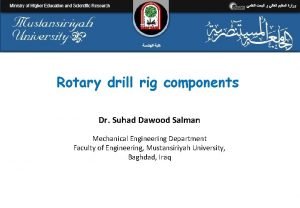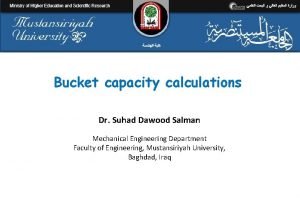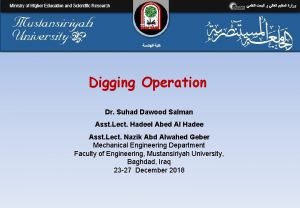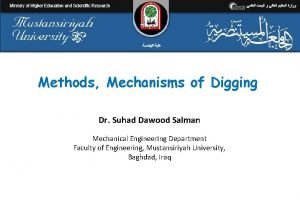Soil stiffness and damping Dr Suhad Dawood Salman










- Slides: 10

Soil stiffness and damping Dr. Suhad Dawood Salman Mechanical Engineering Department Faculty of Engineering, Mustansiriyah University, Baghdad, Iraq

Most methods that deal with the characterisation of the soil under cyclic loading conditions focus on determining the evolution of two facets of the soil behaviour over the course of the loading cycles: the soil’s stiffness and damping characteristics. Stiffness, in the context of material (and, more specifically, soil) mechanics, measures the resistance of a material to being deformed when subjected to an applied loading, and as such governs the relationship that is established between stress and strain over time. If a soil is being stressed, that may have as a consequence the rearranging of particles inside the soil, which will result in material strains. These material strains, for a given loading, are governed by the stiffness characteristics of the soil. These characteristics are very important in the context of soil mechanics and its application to geotechnical design, since they govern the movements of the soil from the very small to the very large scale.

Damping, in the context of cyclic loading, can be understood as the dissipation of energy that follows a loading of the soil. It has a very important effect on the consequences of the cyclic loading of soils. For example, if a soil that had no damping were to be excited by an external momentary load that would cause it to vibrate, it would vibrate indefinitely and with unchanging amplitude. Soil damping allows such an excitation to decrease over time until it is no longer felt. Similarly, for loading frequencies close to the soil’s resonance frequency, the amplification phenomenon is less grievous the more damping the soil exhibits. This is especially important to mitigate the consequences of, for example, seismic activity. When talking about damping, it is important to distinguish between material damping and radiation damping, the former being the dissipation of energy through internal soil friction, and the latter the dissipation of energy from the natural spreading of energy/motion waves through space. Of these types of damping, only material damping is dependent on the soil’s characteristics and not on the soil’s overall geometry and boundaries. Therefore, material damping will be the type of damping that is given the most focus in this work. Unless stated otherwise, from now on any mentions of damping in this work should be taken to mean material damping.

Experimental Description of Soil Behaviour It is commonly admitted for site response analyses, or for soil structure interaction problems, to consider that the seismic horizontal motion is caused by the vertical propagation of horizontally polarized shear waves. Under those conditions, a soil element within the soil profile is subjected to stress cycles similar to those presented in Figure .

Idealized stress cycle during an earthquake.

Initially, for a horizontally layered profile, the soil element is in equilibrium under the vertical effective stress σv ′ and the horizontal effective stress K 0 σv ′ where K 0 is the at rest earth pressure coefficient. When the wave travels through the soil profile an additional shear stress Ƭ (t) is superimposed on the horizontal faces of the soil element and, hence on the vertical ones to maintain equilibrium conditions. Under the action of this stress, the soil element undergoes a shear strain, which for an elastic material is accompanied by a zero volumetric strain. The shear strain, also called distortion, is defined by:

Soil stiffness and shear modulus For cyclic loading conditions, and especially at low to medium strain amplitudes, the stiffness of the soil is well represented by a parameter called the secant shear modulus, Gsec. For the sake of convenience, the secant shear modulus is often referred to as simply the shear modulus, G, which is the designation that will be used in this work henceforth. The shear modulus is expressed in units of pressure, and is defined as the ratio of shear stress, Ƭ, to shear strain, ɣ , i. e. :

At very small strains the shear modulus of a soil is at its maximum. This modulus is often called the maximum or initial shear modulus, respectively, Gmax or G 0. The initial shear modulus of a soil can be directly related to the speed that shear waves attain while travelling through the material, vs, through :

It is common to define, for a given soil, its reference strain, Ƴr, which is the strain for which the soil mobilizes its maximum shear strength, Ƭf , with its initial sh It is common to define, for a given soil, its reference strain, Ƴr, which is the strain for which the soil mobilizes its maximum shear strength, Ƭf , with its initial shear modulus. This relationship is expressed by:

Thank you for listening
